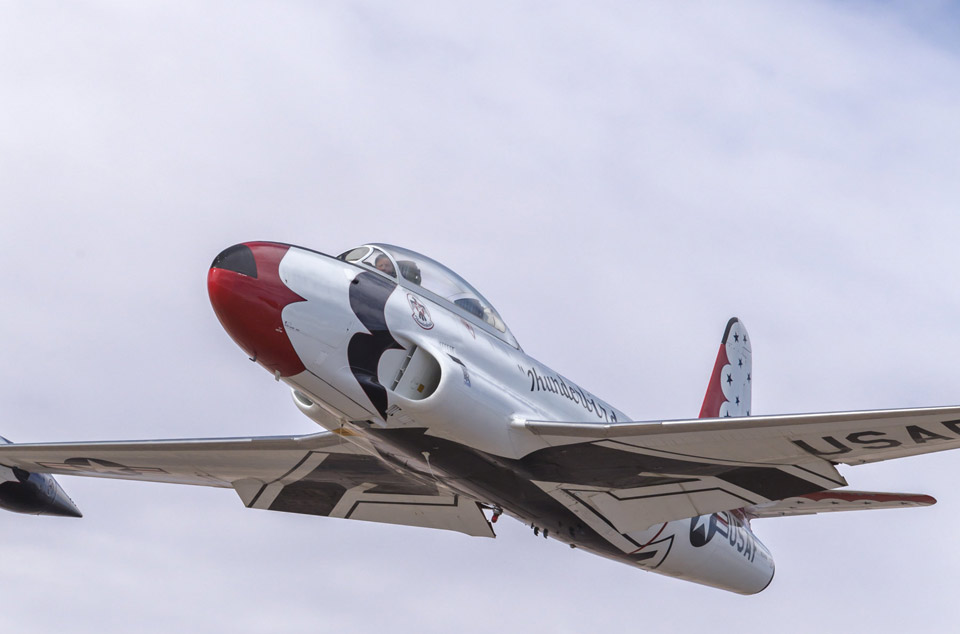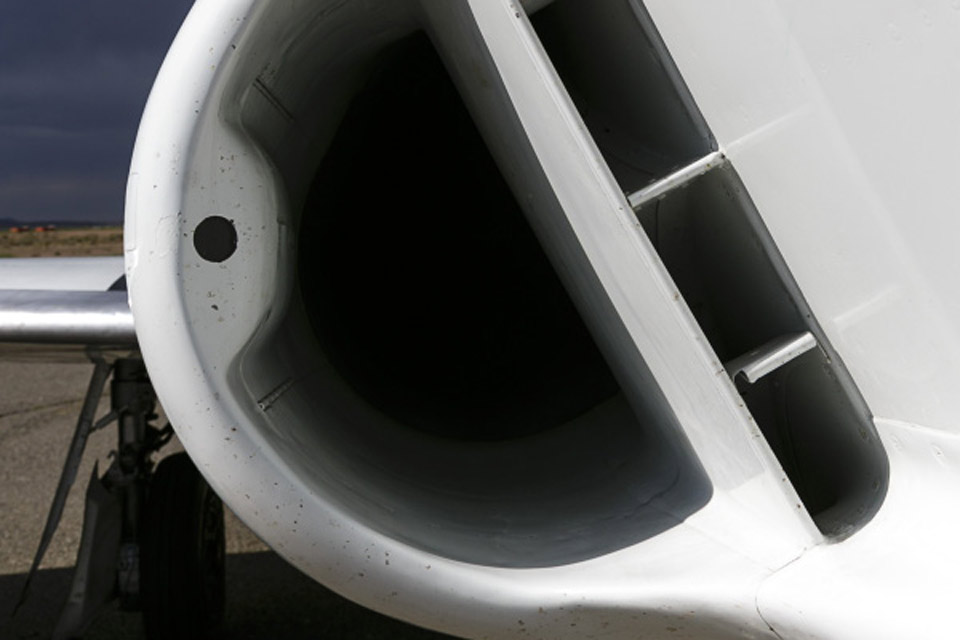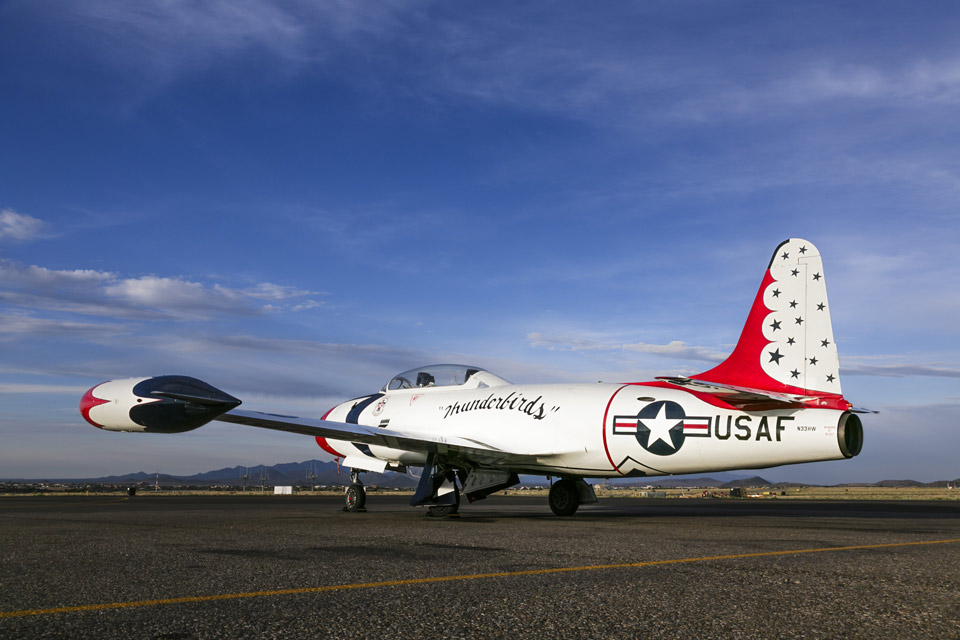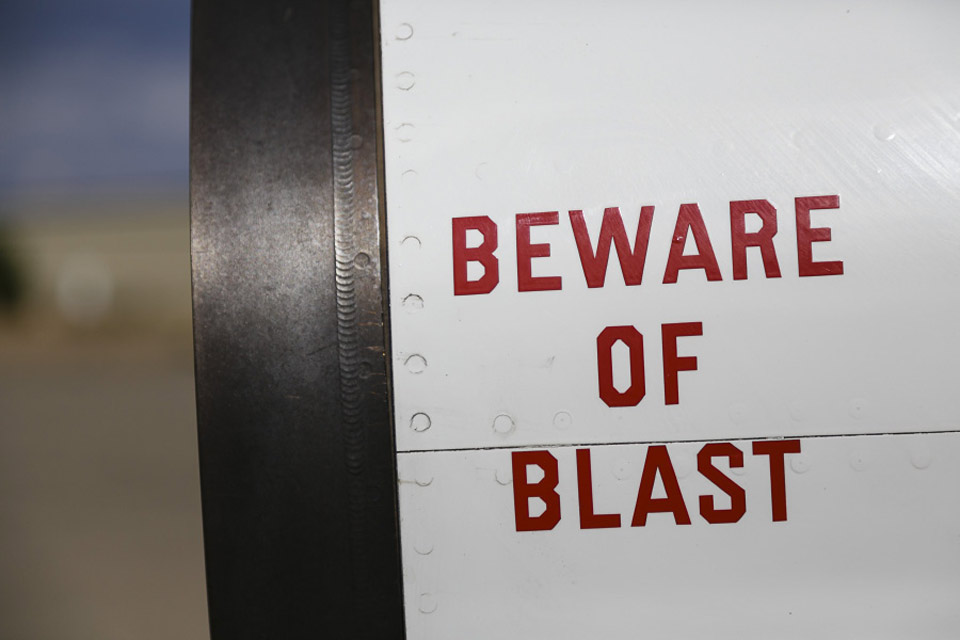Lockheed T–33 shooting star: Taming the T-Bird
Flying America’s first jet trainer
America’s first operational jet fighter was the Lockheed P–80 Shooting Star, which first flew in 1944. Unfortunately, the propeller-driven trainers of World War II could not prepare pilots well for flying turbojet airplanes. Problems encountered during transition to the jet included difficulty slowing during the landing approach, because the P–80 did not have propeller drag to help it slow down. When initiating a go-around, early jet engines responded (spooled up) very slowly. Because of these and other characteristics about which piston pilots had no experience, the P–80 suffered a high loss rate.
Shooting Star designer Clarence “Kelly” Johnson suggested that a jet trainer could easily be made available by stretching the Shooting Star by 41 inches to accommodate a second cockpit in tandem with the first. Both would be covered by a distinctive, single-piece, seven-foot-long clamshell canopy. The result was the Lockheed T–33A Shooting Star, a dedicated trainer that first flew on March 22, 1948, and became affectionately known as the T-Bird.
Although only 1,718 of the fighters were built, Lockheed produced 5,691 T-Birds between 1948 and 1959. Production quality was reportedly so high that only one out of four (selected at random) was flight-tested before delivery. Canadair and Kawasaki of Japan built an additional 866 T-Birds under license. The aircraft featured here, N33HW, was built in 1953 by Canadair. Technically, it is a CT133 Mk3 Silver Star but is otherwise identical to the T–33A.
Beyond my enthusiasm to fly almost anything with wings was an additional motivation—to compare what it was like flying early jets with flying modern, turbofan airplanes. As you might expect, the T-Bird’s instrumentation and systems are old, little improved from World War II aircraft. The most significant difference between the T–33 and modern jet aircraft, however, is its engine.
When air enters the inlet of a modern engine, it flows through the engine’s core and follows a path more or less parallel to the engine’s longitudinal axis, which is why such an arrangement is called an axial-flow engine.
The T-Bird’s Allison J33-A-35 turbojet engine is different, a direct descendant of the original turbojet engine invented by Sir Frank Whittle. It incorporates a single-stage compressor that centrifugally whirls and flings the air outward, much like the centrifugal compressor of a turbocharger, explaining why such a design is called a centrifugal-flow engine. The compressed induction air then enters a ring of diffusers and is channeled into nine combustion chambers. (The engine in the Canadian-built T–33 is the Rolls-Royce Nene Mk.10, which is essentially the same as the Allison.)
The centrifugal-flow engine is remarkably inefficient; 75 percent of its power is needed just to drive the compressor and only 25 percent is translated into thrust. Interestingly, the Soviet Union reverse-engineered (copied) the T–33’s engine and used it to power the MiG–15.
There is only one place to go if you want to fly a T-Bird, and that is the Jet Warbird Training Center in Santa Fe, New Mexico, which is owned and operated by the affable Larry Salganek (see “P&E: Flying the MiG–15,” June 2014 AOPA Pilot). In addition to the T–33, his school offers training in an Aero L–29, an Aero L–39, a V-tailed Fouga CM.170 Magister, and a MiG–15.
Salganek says that young corporate pilots who see the T-Bird on the ramp usually don’t recognize it. Instead of asking what it is, they more often ask about its avionics. And with the canopy raised and a ladder tacitly inviting them to climb up and take a look, they seldom do. Once aboard, though, a general aviation pilot instantly begins to feel like a fighter pilot. The Walter Mitty experience begins.
You look forward through a three-panel windshield. The center panel is bulletproof to protect against a bird strike. The canopy is operated electrically but can be cranked by hand when power is unavailable. It may not be opened in flight but can be jettisoned in an emergency. (The rocket-powered ejection seats in this aircraft thankfully are not operational.)
Unlike modern turbine aircraft, the fuel totalizer indicates quantity in gallons instead of pounds. This helps a T-Bird pilot to easily estimate remaining range, because at altitude the airplane gets about 1 mile per gallon.
You start the engine using the aircraft battery or a ground-power unit. Be careful about starting with a tailwind blowing up your tailpipe, however. Unburned fuel in the exhaust can result in spectacular torching.
Differential braking is needed to turn the nosewheel while taxiing. This is done in most airplanes without nosewheel steering by applying light pedal pressure to one brake or the other. But in a T-Bird, you need to tap the brake hard enough to make the nose of the airplane dip slightly. But don’t be too aggressive—if you cause the nosewheel to cock to its 45-degree maximum, the remainder of your taxi will be embarrassingly circular and might require calling for someone to straighten the nosewheel from outside the airplane. There are no magnetos to check. Just lower the split flaps (like those on a Cessna 310) to 32 degrees, run up the engine to 90-percent rpm to check oil pressure, and you’re ready.
Do not advance the throttle too rapidly at the beginning of takeoff. This can destroy the engine because of an inherent limitation of the centrifugal-flow design. It cannot process inlet air fast enough at low airspeed to prevent the excessive exhaust-gas temperatures that can result from rapid throttle advancement. This limitation also means that the engine cannot get enough air during the takeoff roll to develop anywhere near full power, nor is there a bypass fan to help pull things along. Takeoff acceleration is anemic.
The rudder becomes effective at 50 knots, but it takes a while to get there. In the meantime, directional control during the roll is maintained with differential braking, a bit of a challenge in a strong crosswind. At 90 knots you apply just enough back pressure on the control stick to establish a 6- to 7-degree nose-high attitude, just enough to elongate the nosewheel strut. You then hold this attitude and roll along on the mains until the T-Bird lifts off on its own at 105 to 115 knots.
The density altitude at Santa Fe during my first T-Bird takeoff was 9,000 feet msl, and the 8,366-foot-long runway seemed barely adequate.
After liftoff, a pilot new to the T-Bird tends to induce something similar to Dutch roll. If the airplane starts to roll back and forth, just hold the control stick steady. Chasing it with the ailerons only makes things worse. This phenomenon is caused by an aileron boost system that does not take effect until the stick is moved more than two degrees beyond center. After a while, though, you get used to this dead band (or neutral zone) and seldom give it thought.
The hydraulically boosted ailerons produce light roll forces that make the airplane a delight to fly. Turn off the hydraulic boost pump, however, and moving the stick will make you feel as though you are trying to mix concrete with one hand. (The rudder and elevators do not need boosting.)
The flaps are retracted during climbout at 140 knots, and simultaneous back pressure on the stick is needed to prevent the nose from pitching down. Normal climb speed is 220 knots.
The pressurization system provides a differential pressure of 3.5 psi, but the cockpit does not begin to pressurize until the aircraft reaches 8,000 feet. This cabin altitude is then maintained until the aircraft reaches 15,000 feet. Above that, cabin altitude climbs almost as rapidly as the airplane does and pilot oxygen is soon required.
Fuel is burned first from the tip tanks, then from the leading-edge tanks, and then from the wing tanks. All of these tanks feed into a fuselage tank that holds about 20 minutes worth of fuel and feeds the engine. The tip tanks automatically remain balanced. Should one fail to feed, the other will stop feeding to prevent an imbalance. Should one tip tank somehow remain full while the other empties, however, the tips will have to be jettisoned—a landing should not be attempted with such an imbalance. Salganek recommends not using aileron trim because this can mask a developing imbalance.
The T-Bird maneuvers beautifully, and you cannot help but feel what it was like to have been a fighter pilot during the dawn of the jet age (except for the shooting, of course). Stalls are unremarkable except that rudder is not used to raise a wing during a stall. Applying right rudder to raise the left wing, for example, causes that wing to drop farther. (Don’t ask. I don’t know.) The ailerons, however, are effective during the stall and are used to control roll, which is contrary to how general aviation pilots are trained.
Because of limited power available at low speed, accelerating out of slow flight using power only (and not diving) is agonizingly slow. You move the throttle fully forward and not much happens. As airspeed builds and additional ram air enters the engine, power and acceleration increase. In other words, it is easier to increase speed when you already have an abundance of it.
Unlike most other jet airplanes, a smidgeon of rudder is needed when rolling into and out of turns. The T-Bird has a yaw string on the nose (like many sailplanes) to admonish a pilot for allowing the airplane to slip or skid. Conventional aerobatics are approved, but rolls are not recommended with full tip tanks. Inverted flight is limited to 30 seconds.
Although I had no desire to observe it, high-speed compressibility at high altitude causes airframe buffeting, reduced elevator effectiveness, and Mach tuck—a nose-down pitching moment that compounds these problems. The trick is to avoid Mach 0.80 above 30,000 feet.
The T–33 does not have spoilers, but it does have a pair of hydraulically operated speed brakes, rectangular surfaces that swing down and forward from the belly. When on the downwind leg at 185 knots, pop these “boards” using the dive-brake switch on the throttle, extend the gear and flaps, and turn base. Target speeds are 125 knots on final and 110 knots over the fence. Touchdown occurs at about 90 knots.
When retarding the throttle during an approach, bring it only as far aft as the “soft stop.” This reduces engine power to 40-percent rpm. Pulling the throttle fully aft (beyond the soft stop and to the hard stop) reduces power to 20 percent (idle). The problem with this is that when the engine is at idle, it can take 15 seconds to spool up to maximum-available power in the event of a go-around (or during touch-and-go landings), and these can be the longest 15 seconds you’ll ever endure.
Lacking spoilers, reverse thrust, or an antiskid system, a minimum of 5,500 feet is needed to make a full-stop landing at Santa Fe on a hot day. Salganek advised me to save the brakes by applying them gingerly and using the entire runway to slow down.
The Air Force began replacing the T-Bird with the Cessna T–37 Tweet in 1957 and the supersonic Northrup T–38 Talon in 1961.
Salganek is a remarkably effective and patient instructor. Throughout our flight he kept telling me how wonderfully I was doing, even though I knew better. Such an instructing style, though, helps a student to relax, have fun, and more rapidly build confidence.
You would suspect that Salganek is an ex-military pilot. Not so. He’s strictly GA and learned to fly in a Cessna 150. He worked his way up the food chain and opened his school in 1991 with a Beech T–34 Mentor. He obtained the T-Bird in 1994 and other exotic jets in subsequent years. His customers range from private pilots to airline pilots to astronauts, many of whom come from all over the world for this specialized training. In addition to offering dual instruction and type ratings in these aircraft, he also offers upset training.
Salganek says that the L–39 is his most popular warbird and that the classic T–33 is inexplicably his least popular. “The T-Bird is a wonderful warbird, but it is very basic and demands a lot of hand-eye coordination. It has little automation and no computerization. You operate it manually in almost every respect,” he said. “It is truly a pilot’s airplane.”
Flying a Lockheed T–33 provides a marvelous sense of aviation history. For someone with jet experience, a T-Bird type rating requires about six hours. I didn’t ask about the cost because I knew that I probably couldn’t afford it. (We checked; the cost is approximately $17,000.—Ed.)
Visit the author’s website (www.barryschiff.com)
The forward instrument panel is little improved from World War II aircraft, but instructor Larry Salganek (center right) cannot see it from the rear seat.
SPEC SHEET
Lockheed T–33 Shooting Star
Specifications
Powerplant | Allison J33-A-35 turbojet, 5,400 pounds thrust
Length | 37 ft 9 in
Height | 11 ft 8 in
Wingspan | 38 ft 11 in
Wing area | 235 sq ft
Wing loading | 64.3 lb/sq ft
Power loading | 2.8 lb/lb thrust
Seats | 2
Empty weight | 8,300 lb
Max gross weight | 15,100 lb
Useful load | 6,800 lb
Payload w/full fuel | 1,353 lb
Max takeoff weight | 15,100 lb
Max landing weight | 15,100 lb
Fuel capacity (wing, tip & fuselage tanks) | 813 gal, 5,447 lb
Performance
Takeoff distance, ground roll | 3,700 ft
Takeoff distance over 50-ft obstacle | 5,600 ft
Rate of climb, sea level | 5,000 fpm
Rate of climb, 30,000 ft. | 1,700 fpm
Max level speed, sea level | 478 kt
Max true dive speed at altitude | 522 kt
Max range (ferry) | 1,109 nm
Cruise performance, 10,000 ft | 375 knots
Fuel consumption @ 87% rpm | 2,513 pph/375 gph
Cruise performance, 20,000 ft | 390 knots
Fuel consumption @ 87% rpm | 1,809 pph/270 gph
Cruise performance, 30,000 ft | 416 knots
Fuel consumption @ 90% rpm | 1,474 pph/220 gph
Cruise performance, 40,000 ft | 452 knots
Fuel consumption, @ 95% rpm | 1,240 pph/185 gph
Service ceiling | 48,000 ft
Landing distance over 50-ft obstacle | 4,650 ft
Landing distance, ground roll | 3,525 ft
Limiting and recommended airspeeds
VX (best angle of climb) | Liftoff speed + 8 KIAS
VY (best rate of climb) | 275 KIAS
VGLIDE (12:1 glide ratio) | 165 KIAS
VFE (max flap extended) | 174 KIAS
VLE (max gear extended) | 195 KIAS
VLO (max gear operating)
Extend | 195 KIAS
Retract | 195 KIAS
VMO (max operating speed) | 505 KIAS
MMO (max Mach speed) | Mach 0.80
VR (rotation) | 90 KIAS
VS1 (stall, clean) | 117 KIAS
VSO (stall, in landing configuration) | 104 KIAS
All specifications are based on manufacturer’s calculations. All performance figures are based on standard day, standard atmosphere, sea level, gross weight conditions unless otherwise noted.
Extra: The Allison turbojet engine was copied by the USSR and used in the MiG–15.
Web: www.jetwarbird.com
VIDEO Extra: Fly along with the author in this online video.












